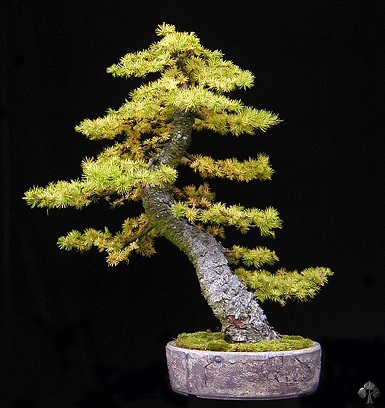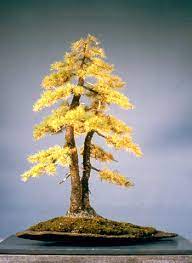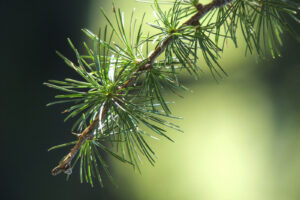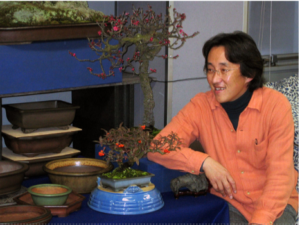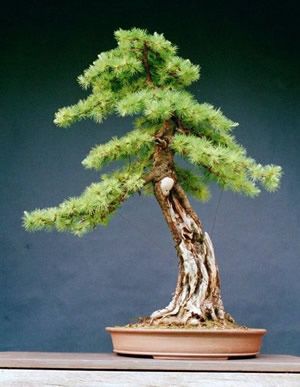
LARCH
The Larch (Larix) is a genus of tall, upright, coniferous trees that are deciduous in contrast to most other conifers. The Larch, also known as Tamarack, is a major tree of the Northern hemisphere. Its natural range extends to northern Canada and even up to the Arctic Circle, where temperatures can dip to -65. Although larch and tamarack are different species, they are in the same genus and can be used interchangeably.
It grows naturally in boggy locations, and therefore as a bonsai, it should not be allowed to dry out. It is the first tree species to invade bogs where the seeds germinate in the sphagnum moss. Its roots eventually drop down through the bog to get to the firm bottom.
Its leaves are needles, so it is classified in the Pinaceae family of trees, even though it sheds them in the fall and is obviously not an evergreen tree.
The three species commonly grown as bonsai trees are American Larch (Larix laricina), the European larch (Larix decidua), and the Japanese larch (Larix kaempferi). The Golden or Chinese Larch (Pseudolarix amabilis) looks quite similar to the Larix, but it is not frost-hardy and needs more moisture.
The Larch is easy to identify in winter and summer as it is the only deciduous conifer tree. In the fall, its needles turn a striking yellow color; after the leaves(needles) fall, the tree has a very twiggy, dead-looking silhouette during the winter. It usually has a straight trunk with upward pointing branches at the top and horizontal branches lower down. The small cones that look like little knobs are attached along the top side of branches providing another distinctive feature. They usually stay on the tree during winter and may stay attached for several years before falling off.
Growth in spring normally starts with small whorls of bright green that resemble shaving brushes on the branches. The needles grow in dense clusters and are soft, not sharp or spiny like other conifers.
What all larches have in common is that they are hardy trees. The wood is extremely tough and rot-resistant. Historically, the root strings were used by Indians to sew birch bark canoes. The colonists used larch for shipbuilding. And today, the wood is used for planking, railroad ties, fence posts, telephone poles, shipbuilding, etc.
Interesting fact, “Because of its forlorn look in winter, in the Civil War era and earlier, it was common to have one in a town cemetery to symbolize ‘death’ in the winter and ‘rebirth’ in the spring.”
STYLING: Suitable for all forms except broom.
PLACEMENT: The Larch grows best in full sun, preferably semi-shaded in summer during the hottest hours. Larix trees are very frost-hardy, but they should be protected from excess rain and wind in winter. The Golden Larch prefers semi-shade during hot summer months and should be protected from drying winds. It is not frost-hardy and should be kept in a cold frame during winter. Note that Larch carrying wire through the winter has been reported to be less hardy.
WATERING: Larches must be watered thoroughly, not letting the soil get too dry. It should be kept evenly moist. The Golden Larch especially needs a lot of water. Never let the rootball dry out and even placing it in a shallow pan of water in summer. Larch kept in full sun during summer can become very thirsty and should be watered frequently.
FERTILIZING: Start feeding heavily after the buds have appeared in spring. You can use a high nitrogen fertilizer first to help the new shoots develop. Continue to feed well until mid-summer, when the tree will enter a semi-dormant period. From late summer onwards, revert to a low-nitrogen fertilizer to strengthen the tree for the coming winter.
PRUNING AND WIRING: The Larch takes regular pruning well. If larger branches must be pruned, this should be done in winter or early spring before the tree buds start growing. Odd and badly positioned buds should be removed before they open. Larches have sticky resin, making cut paste obsolete; they grow strong callus tissue that closes cut wounds quite quickly. Maintenance pruning should be done throughout the year by pinching back new shoots. Allowing new growth to extend first before pinching back will allow the branches and trunk to thicken. For coniferous species, larches are very vigorous and can replace newly pruned growth within a matter of weeks. Larches should be wired before the fragile buds begin to swell in spring. The twigs and branches thicken quickly during the growing season, and the wire must be taken off before it bites too deeply into the bark. Moderate wire marks will grow over quite fast, at the latest when the bark becomes flaky.
REPOTTING: Larches resent being pot-bound and need repotting every 1-2 years in spring as buds extend. Larch generally resents root disturbance. Do not bare-root and do not remove more than one-third of the root mass. Except for dry soil, larch adapts well to any type of soil.
PESTS AND DISEASES: Larix Bonsai and Pseudolarix can be attacked by mealybugs, black aphids, tiny aphids which leave kinked and drying needles, caterpillars, bark beetle larvae, gall midges, sawfly, and fungal diseases like grey mold rot. The most common disease is Larch Needle Cast. These can be treated with the appropriate insecticide or fungicide.
PROPAGATION: Larches can be propagated from seed. Seeds must go through the natural winter dormancy process, and then the viable seeds will sprout in the spring, preferably in consistently wet sphagnum moss. For best growth, larch/tamarack seedlings need lots of light and a constant but suitable water level. Cuttings can be difficult to root through semi-ripe cuttings can be taken in late summer, and hard-wood cuttings can be taken during winter. Air-layering is successful and can be taken in late spring
written by Charlotte Field
References: How to Grow Larch Trees by Nadia Hassani, Bonsai Empire, Anne Krantz, and BCI Magazine. And please remember, the books and magazines are available from our PSBS library.
